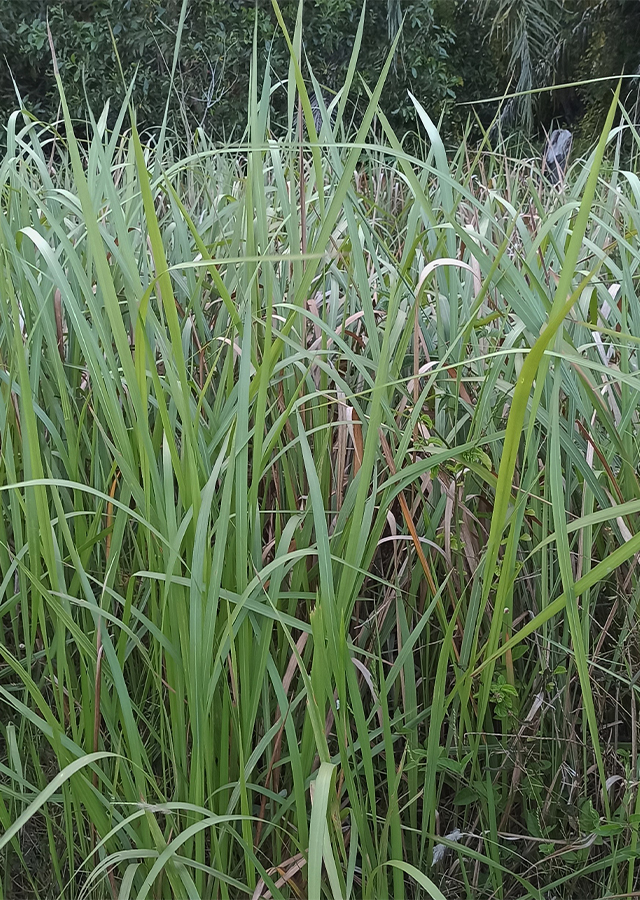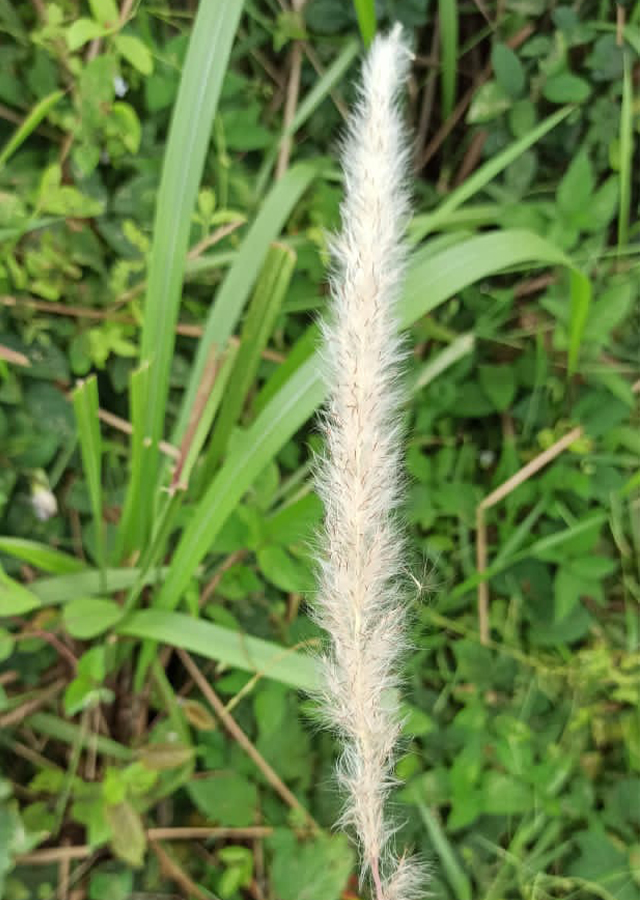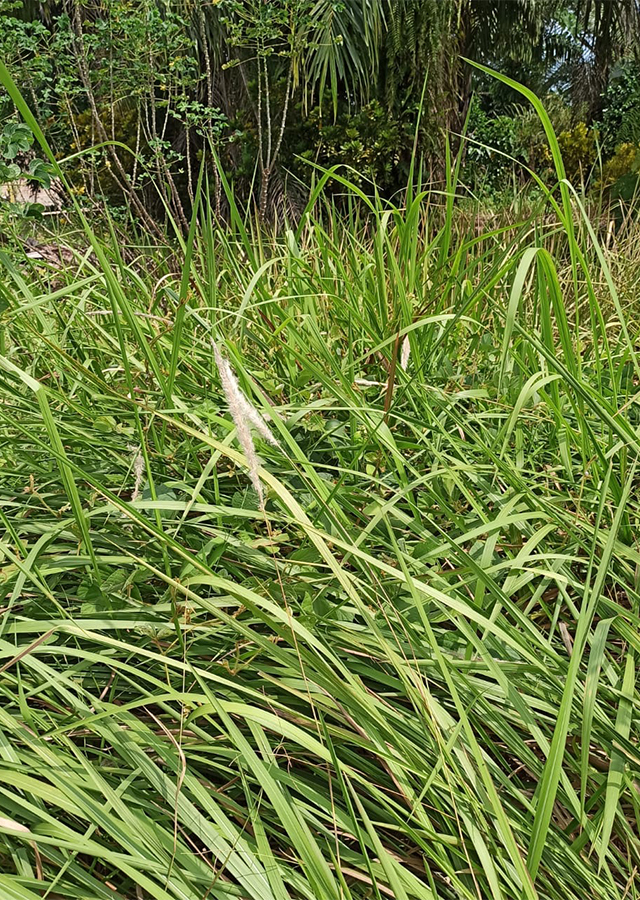Cogon Grass
Imperata cylindrica (L.) P.Beauv.
Poaceae
Location in our garden
Beneficial Weed



Synonym
Arundo epigeios Forssk. ex Steud.
Calamagrostis lagurus Koeler
Imperata alang Jungh.
Habitus
Herbaceous. A perennial grass, erect, solid, growing around 120 cm tall
Part Used
Leaves
Roots
Growing Requirements
Full Sunshine
Habitat
Riverbanks
Coastal
Overview
In the tropics and subtropics of Africa, the Indian subcontinent, South-East Asia and Australia are the native range. Cogon grass is widely distributed. In North , Central and South America, it occurs to a lesser degree and is also present in warm temperate areas, being recorded in New Zealand and Japan.
Vernacular Names
Satintail (En). Paillotte (Fr). Malaysia: lalang, alang-alang. Papua New Guinea: kunai (Pidgin), kurukuru (Barakau, Central Province). Philippines: kogon (Tagalog), gogon (Bikol), bulum (Ifugao). Burma (Myanmar): kyet-mei. Cambodia: sbö’:w. Laos: hnha:z kh’a:. Thailand: ya-kha, laa laeng, koe hee (Karen, Mae Hong Son). Vietnam: c [or] tranh.Kyet-mei (Burmese), Lalang (Malaysia), Bái-máu (Taiwanese), Tsubana (Japanese), Bladygrass (Australia).Indonesia: Naleueng lakoe (Aceh); Jih (Gayo); Rih, Ri (Batak); Oo (Nias); Alalang, Hilalang, Ilalang (Minang kabau); Lioh (Lampung); Halalang, Tingen, Padang, Tingan, Puang, Buhang, Belalang, Bolalang (Dayak); Eurih (Sunda); Alang-alang kambengan (Jawa); Kebut, Lalang (Madura); Ambengan, Lalang (BaIi); Kii, Rii (FIores); Padengo, Padanga (Gorontalo); Deya (Bugis); Erer, Muis, Wen (Seram); Weli, Welia, Wed (Ambon)
Agroecology
Imperata cylindrica occurs with 75 to 500 cm of annual rainfall in a wide variety of habitats, including degraded forests, grassland, arable land, and young plantations in tropical and subtropical climates. In almost all eco-types, it can be found growing from the dryest flatwoods to the margins of permanent bodies of water.
Morphology
- Roots are fibrous, emerging from the base of the culm and the nodes on the rhizome.
- The rhizomes (underground stems) are tough, white, usually 1 m long, but can be significantly longer, are branched extensively and covered at the nodes with papery scale leaves.
- Leaf 20-100 x 1.2-1.6 cm leaf blades, rigid, smooth, upright, steadily tapering to a point, prominent midrib, very rough margin with tiny teeth.
- Spikelets lanceolate or oblong spikelets, 3-4 mm long, all alike, in pairs, from a slender continuous axis on unequal pedicels, disarticulating at maturity.
Cultivation
Propagated by seed and rooted tillers.
Chemical Constituents
Manitol, glucose, sacharosa, citric acid, malic acid, cylindrin, fernenol, coixol, arundoin, amemonin, semiarenol, kersic acid.
Traditional Medicinal Uses
Medicinal Uses
- Viricidal and anticancer activity is shown by extracts of the plant.
- Anti-bacterial, diuretic, febrifuge, sialagogue, styptic and tonic are the flowers and roots. The blossoms are used to treat haemorrhages, burns, etc.
- The root is astringent, antifebrile, emollient, antivinous, diuretic, restorative, tonic and haemostatic. It is used in the treatment of bleeding in the nose, haematuria, haematemesis, jaundice and oedema. Against Staphylococcus aureus, Bacillus dysenteriae etc, the root has antibacterial action.
Traditional Uses
- A rhizome decoction is usually drunk as a diuretic, used as an embrocation for coughs to purify the blood and to treat dysentery, colic, hypertension and venereal diseases, treat cough, and the pulped-up plant with shea butter is used as a cough embrocation.
- For the prevention of fever and malaria, a decoction of the aerial sections or leaves is drunk and sometimes used as a wash to treat furuncles and aphthae.
- As an aphrodisiac, roasted and powdered roots are taken from palm oil.
- The root is chewed in Uganda to treat snakebites, a root decoction is taken in Namibia to treat jaundice and digestive problems, and a crushed root infusion is taken in southern Africa to treat hiccups and indigestion.
- The stems are used in a proprietary anti-tumour preparation in Japan.
Part Used
Reference Sources
Arifin, S. 2012. Tanaman Obat Herbal Alang Alang Imperata cylindrica (L.) Beauv (accessed 31 Desember 2021) http://habibi.staff.ub.ac.id/2012/11/11/tanaman-obat-herbal-

